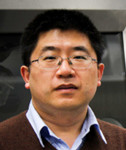
Dr. Lifeng Liu
the International Iberian Nanotechnology Laboratory, Portugal
Title: Transition Metal Phosphide Water Splitting Electrocatalysts
Abstract:
Water splitting has been proposed to be a promising and highly desirable approach to solar energy storage in the form of clean hydrogen fuels. This can be realized either by water electrolysis powered by photovoltaic cells or by direct photocatalysis/photoelectrocatalysis using semiconducting materials, both requiring low-cost, efficient, and stable catalysts containing earth-abundant elements for large-scale deployment.
In this talk, I will first present our recent effort toward developing self-supported transition metal phosphide (TMP) monolithic electrodes for alkaline water electrolysis [1-3], which can be powered by “green” electricity from solar cells. I will then focus on our recent work on fabricating silicon (Si)-based photocathodes for solar driven water splitting. Specifically, I will show a few examples including 1) Si nanowire (SiNW) arrays fabricated by metal-assisted chemical etching and decorated with earth-abundant cobalt phosphide (Co-P) nanoparticle catalysts [4]; 2) conformal and continuous deposition of Co2P catalyst layers on p-Si NW arrays and inverted pyramid textured p-Si wafers [5,6]. In both cases, the CoP layer plays a dual role: on the one hand, it serves as an efficient catalyst promoting the hydrogen evolution reaction; on the other hand, it effectively passivate Si against the photo-corrosion, substantially improving the operation lifetime of the photoelectrodes.
[1] X. Wang, Y. V. Kolen’ko, X. Bao, K. Kovnir, L.-F. Liu, Angew. Chem. Int. Ed. 2015, 54, 8188.
[2] X. Wang, W. Li, D. H. Xiong, L.F. Liu, J. Mater. Chem. A 2016, 4, 5639
[3] X. Wang, W. Li, D. Xiong, D. Y. Petrovykh, L.-F. Liu, Adv. Funct. Mater. 2016, 26, 4067.
[4] X.Q. Bao, M. F. Cerqueira, P. Alpuim, L.F. Liu, Chem. Commun. 2015, 51, 10742.
[5] S.M. Thalluri, J. Borme, K. Yu, J.Y. Xu, I. Amorim, J. Gaspar, L. Qiao, P. Ferreira, P. Alpuim, L.F. Liu, Nano Res. 2018, 11, 4823-4835.
[6] S.M. Thalluri, B. Wei, W. Katharina, T. Rajesh, S. Vladimir, L. Qiao, Z.C. Wang, F. Finger, L.F. Liu, submitted to ACS Energy Lett.
Biography:
Lifeng Liu (Researcher ID: A-2522-2012, Orcid ID:
0000-0003-2732-7399) is currently Senior Staffer Researcher (tenured) and Research
Group Leader at the International Iberian Nanotechnology Laboratory (INL) – the
first international research organization worldwide in the field of nanoscience
and nanotechnology. He obtained his B. S. degree in Applied Physics from
Beijing Jiaotong University (2001), and both his MS (2004) and PhD (2007)
degrees in Condensed Matter Physics from the Institute of Physics, Chinese
Academy of Sciences (IOP-CAS). He joined Max Planck Institute of Microstructure
Physics – Halle (MPI-Halle), Germany in 2007, first working as a postdoctoral
researcher and then as a staff scientist. He started his independent research
career in 2008 and became the head of group “Porous Alumina” in 2009. In 2011,
he moved to INL and set up a research group there. Lifeng Liu has been actively
working on nanomaterials and nanostructures since 2002, with particular
emphases on fabrication and characterization of complex nanostructures, nanoscale
solid-state reactions, ferroelectric nanostructures and nano-electrocatalysts.
His present interest mainly focuses on nanomaterials for renewable energy
generation, storage, and conversion. So far, he has been granted 2 PCT patents
and authored/coauthored 130+ peer-reviewed papers in major international
journals, which have been collectively cited 7000+ times (Google Scholar, as of
Jan. 2019). In addition, Lifeng Liu has delivered about 50 oral presentations
at different international conferences/workshops/universities. Honors and
awards he was granted recently include: FCT Investigator Grant 2014, Young
Researcher Award 2015 by the Portuguese Electrochemical Society, and the
Scientist Medal by the International Association of Advanced Materials (IAAM)
2018.